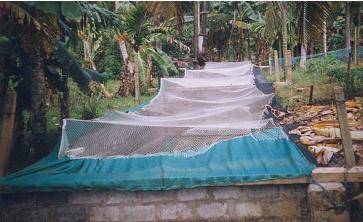|
Nursery Phase
The nursery can be either indoor or outdoor. The selection of sites for indoor nurseries
should follow the same pattern as for hatcheries. Site selection for outdoor nursery
facilities should be similar to that for grow-out ponds.
Holding Tanks
After rearing freshwater prawns in hatchery, hold them until ready for stocking
in ponds. Concrete tanks of 50 m3 are convenient for holding postlarvae
(PL) prior to transport for stocking in ponds. Use nets suspended from floats in
the tanks to increase the surface area available to the PL but this may make the
normal operations of feeding, cleaning etc. more difficult.
Indoor Nursery Facilities
Tanks for indoor freshwater prawn nurseries can be constructed from concrete or
fibreglass. The use of asbestos cement tanks is not recommended. The shape of nursery
tanks is not important and their size, usually from 10 to 50 m2 with
a water depth of 1 m. The best stocking density for indoor nursery tanks depends
on the length of time the animals will remain in the tanks before transfer to an
outdoor nursery or grow-out facility. It is recommended not to exceed a stocking
density of 1000 PL/m3 in tanks without substrates.
Artificial substrates of various designs and materials can be used to increase surface
area; these provide shelter and increase survival rates. Layers of mesh can therefore
be used to increase the amount of surface edges available to the prawns in both
vertical and horizontal planes. The water supplies for indoor nurseries can be flow-through
or recirculating. For flow-through, water is allowed to continuously enter from
above the tank and exit from the lowest part of the tank through a vertical standpipe.
Standpipes are covered with a 1.0 mm mesh screen to prevent PL and juveniles from
escaping. This drainage system draws water from the tank bottom where food waste
and detritus settle.
Outdoor Nursery Facilities
Nursery ponds are similar to grow-out ponds in design and facility requirements.
They usually vary in area from 300 to 2000 m2 . Artificial substrates
can be used to increase the surface area available to the prawns. PL is retained
in holding tanks for more than a week or two prior to stocking in nursery facilities,
grow-out ponds. Whilst the PL are in the holding tanks water is exchanged at a rate
of 40-50% every 2-3 days and provide aeration. PL is at densities of up to 5000
PL/m2 for one week, or up to 1500-2000 PL/m2 for one month
under these conditions. If you need to hold them for one month, you could improve
survival if you reduce the density to 1000/m2. Using substrates can help
you maximize the stocking density, thus reducing other equipment and labour costs.

A concrete indoor nursery

An outdoor grow-out nursery
Top
|